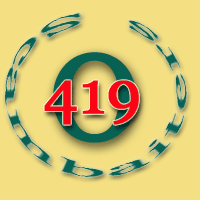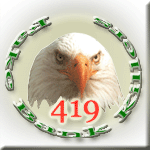
• Home •
Victim´s Story •
Fraud Prevention •
Project GSO •
Hall of Shame •
LINKS •

What means Counterfeit Check Fraud?
Types of Check Fraud
by occ.treas.gov
2006
Check fraud isn't restricted to the accounts payable and payroll checks of businesses. Virtually all types of checks are targeted for fraud. Some of the other types of checks targeted are: other corporate checks (T&E, commissions, claims, dividends, freight, refunds, etc.), money orders, cashier's or teller's checks, certified checks, traveler's checks, postal money orders, pre-authorized drafts, personal, and government checks (federal, state and local). Regardless of the purpose for paying the check there is the potential for check fraud.
Some of the types of check fraud include:
- Counterfeit
- Altered
- Forgery
- Closed Account (Paperhanging)
- New Account
- Identity Assumption
- Kiting
Counterfeit
Counterfeit checks are imitations or copies of genuine checks. They are drawn on valid bank accounts and the checks may or may not be a precise duplicate of an actual check it just has to have valid bank account information. This type of fraud can be committed with or without valid check stock or signatures.
Some criminals will order check stock through a mail order company with accurate company information printed on the checks, others will use computers, software and other tools to generate their own versions of a company's checks.
Counterfeit checks, also includes checks that are presented for payment using fraudulent identification.
Altered
Occurs when a legitimate check is issued by a valid drawer and is altered without the drawer's approval. Either the payee or a criminal, who has illegally obtained the check, modifies the dollar amount or payee name and attempts to present the check.
Chemical agents or other means can be used to erase or alter the amount of the check or the name of the payee so that new, fraudulent information can be entered. Highly secure check stock can help guard against altered check fraud.
Forgery
Forgery refers to stolen checks. Legitimate, and unused, check stock is acquired by criminals who then create bogus checks and forge the payor signature.
Forgery also includes forged endorsements, where a valid check is issued but the is lost or stolen before the payee receives it. The payee's endorsement is then forged and a criminal represents himself as the payee.
Closed Account (Paperhanging)
This type of fraud is based on checks being written against closed accounts and exploits the float time involved between depositary and paying banks. Criminals either obtain checks for the closed account or create their own and deposit the checks in an account at another bank. Criminals exploit the lag between the availability of funds provided by the depositary bank and the notification by the paying bank of the closed account status. Closed account fraud is helped when companies don't destroy check stock from closed accounts or when they are lax in notifying banks of their account status.
New Account
Criminals open bank accounts using either fraudulent identification or by assuming the identity of others and commit fraud by depositing bogus checks. Criminals exploit the lag between the availability of funds provided by the depositary bank and the notification by the paying bank of the returned bogus check.
Identity Assumption
This type of fraud involves obtaining information on a bank customer such as account and company information, and then misrepresenting themselves as the valid bank customer. If successful in obtaining the necessary information and assuming the identity of the bank customer, criminals can change existing account information, open new bank accounts, change bank services, create fictitious transactions or prepare checks drawn on valid accounts. Kiting Kiting is the process that takes advantage of float to create fraudulent balances with two or more bank accounts at two or more institutions.
Kiting
Kiting is the process that takes advantage of float to create fraudulent balances with two or more bank accounts at two or more institutions.
Why It's Growing
There is no single reason for the continuing increase in check fraud activity there are many reasons that contribute to the rise of check fraud in the 1990's. According to the Office of the Comptroller of the Currency between 1991 and 1993 the number of fraudulent checks increased 136%. Check fraud has increased steadily throughout the 1990's and shows little signs of abating. There are many factors leading to increased check-fraud losses including:
- Technological Advances
- TDecreasing Cost of Technology
- TDifficulty in Detection
- T Regulations
- TCompetitiveness of Banks
- TComputers vs. Guns
- TWhite-collar Crimes
- TGangs finance other criminal activities
- TCheck Fraud is a Local Crime
- TRevised UCC Regulations
Technological Advances
Prior to the 1990's check fraud was committed primarily by "insiders", either employees of a company or bank, who had access to preprinted check stock and/or account information. It was hard for "outsiders" to commit check fraud mostly because of the high cost of printing equipment needed to produce counterfeit checks. In the 1990's technological advances in laser printers, computers, scanners and desktop publishing software has allowed a new class of criminals to commit check fraud.
Decreasing Cost of Technology
Along with the technological advances, decreasing costs and wide spread availability of these products have made even sophisticated tools affordable to obtain. Now almost anyone with a basic knowledge of computers and software can attempt check fraud. Criminals have easy access to all of the tools necessary to commit check fraud and with the aid of these tools no specialized knowledge or skills are needed.
Difficulty in Detection
Given that over an estimated 65 billion checks are processed in the U.S. each year it isn't feasible that banks can visually inspect each check for authenticity. The high-speed processing equipment used to process those checks isn't capable of detecting the increasingly sophisticated counterfeit checks. At times even visual inspection can't determine if a check is counterfeit. Using a positive pay service would identify counterfeit checks upon presentment. However, without positive pay any counterfeit checks may not be detected until a company receives and reviews their bank statement, which is too late to avoid losses.
Availability Regulations
In 1987 Congress passed the Expedited Funds Availability Act (EFAA), which established the maximum hold periods that banks can place on funds deposited by checks. The Federal Reserve implemented the EFAA's provisions in Regulation CC. Generally, local checks (checks payable by banks located in the same check-processing region as the depositary bank) must be made available for withdrawal within two business days of deposit. For non-local checks it is five business days. Most check fraud is with local checks given that banks have less time to verify the authenticity of checks. By the time a paying bank notifies the depositary bank of a fraudulent check the criminals have withdrawn the funds.
Competitiveness of Banks
The increasingly competitive banking and financial services industries has led to some institutions providing availability of funds even quicker than required Reg. CC.
Computers vs. Guns
For criminals check fraud is much less risky than armed bank robbery, but the intent is the same, to steal money from banks. Rather than enter the highly secure physical bank branches with a gun or weapon, criminals are increasingly opting to stay at home and create fraudulent checks with computers and laser printers and then enter the bank as a customer, depositing and withdrawing their fraudulent checks.
White-collar Crimes
In the 1990's violent and drug related crimes have been a priority for law enforcement agencies. Non-violent "white-collar" crimes such as check fraud garner much less attention and focus from the law enforcement community. As a result investigations, prosecutions and prison terms for check fraud tend to be less than for other crimes, especially crimes labeled "violent crimes".
Gangs finance other criminal activities
Criminals, even violent ones, are aware of the priorities of law enforcement agencies. Increasingly, organized gangs are using check fraud as a low risk, and profitable, means to finance their expansion into other more violent crimes. In 1996 the FBI estimated that organized criminal groups drove approximately 50% of the stolen and counterfeit check activity.
Check Fraud is a Local Crime
Although the problem of check fraud is national in scale, investigations are usually conducted by local law enforcement agencies. Generally the FBI and national law enforcement will only get involved if the fraud exceeds $100,000 or it is determined that interstate activity has occurred. However, it may be difficult to determine if multiple check fraud losses are related to the same scheme or perpetrator. Also, local law enforcement may have threshold limits of their own that must be exceeded before actively investigating or they may not regard check fraud as a serious problem.
Revised U.C.C. Regulations
It is debatable whether the revisions to the U.C.C. Code regarding check fraud liability has contributed to the growth in check fraud in the 1990's. Before adoption of articles 3 and 4, which governs negotiable instruments and check collection respectively, of the U.C.C. in the early 1990's banks usually absorb the losses from check fraud, wanting to maintain good relations with their customers. However, the changes in the U.C.C. introduced "negligence" and "ordinary care" as determinants of liability for check fraud losses. With approximately ten thousand banks and ten million companies in the U.S. any shift, whether perceived or not, from banks to companies diffuses the responsibility and vigilance for fighting check fraud.
Check Fraud Links
The National Check Fraud Center - Everything you ever wanted to know about check fraud and more. A bit outdated but lots of statistics and research links.
ckfraud.org
Financial Crimes Enforcement Network - A great site for U.S. Companies with global operations that rely heavily on electronic cash management.
fincen.gov
American Bankers Association
aba.com
Bank Administration Institute bai.org
National Automated Clearinghouse Association nacha.org
Uniform Commercial Codes 3, 4 and 4A - An in depth and comprehensive breakdown of these codes from the Cornell University Law Library
http://www.law.cornell.edu/ucc/3/overview.html
http://www.law.cornell.edu/ucc/4/overview.html
http://www.law.cornell.edu/ucc/4A/overview.html
Banking Industry Legal Resources and Overview - Via the Cornell University Law Library
law.cornell.edu
© by GSO • Contact